Abstract
Globally, building energy consumption has been rising, emphasizing the need to reduce energy usage in the building sector to lower national energy consumption and carbon dioxide emissions. This study analyzes the applicability of photovoltaic (PV) systems in enhancing the energy self-sufficiency of small-scale, low-rise apartment buildings. The analysis is based on a case study using Republic of Korea’s Zero-Energy Building Certification System. By employing the ECO2 simulation program, this research investigates the impact of PV system capacity and efficiency on the energy self-sufficiency rate (ESSR). A series of parametric analyses were carried out for various combinations of building-attached photovoltaic (BAPV) roofs and building-integrated photovoltaic (BIPV) facades, considering the initial cost of BIPV facades. The simulations demonstrate that achieving the target ESSR requires a combination of BAPV roofs and BIPV facades, due to limited roof areas for PV systems. Additionally, this study reveals that BIPV facades can be cost-effective when their unit price, relative to BAPV roofs, is below 62%. Based on the ECO2 simulations, a linear regression formula is proposed to predict the ESSR for the case study building. Verification analysis shows that the proposed formula predicts an ESSR of 74.1%, closely aligned with the official ESSR of 76.9% certified by the Korean government. Although this study focuses on the case of a specific apartment building and lacks actual field data, it provides valuable insights for future applications of PV systems to enhance energy self-sufficiency in small-scale, low-rise apartment buildings in Republic of Korea.
1. Introduction
Globally, the building sector constitutes a substantial portion of national energy consumption. According to the International Energy Agency (IEA), the building sector accounts for over 40% of energy consumption in North America, more than 37.3% in Europe, and above 24% in Asia. Specifically, residential buildings represent over 17% in North America, 25% in Europe, and 19% in Asia, in terms of the total energy consumption []. The U.S. Energy Information Administration (EIA) similarly reports that the building sector represents approximately 21% of total energy consumption in the United States, with residential buildings accounting for about 11% []. The Korea Energy Economics Institute (KEEI) indicates that the building sector comprises about 22% of national energy consumption, with residential buildings making up about 11% []. According to the KEEI, the important fact is that energy consumption in the building sector is continuously increasing [].
The government in Republic of Korea introduced the Zero-Energy Building Certification (ZEBC) System in 2017, aiming to reduce energy consumption in the building sector. Since 2020, the ZEBC requires public buildings to achieve an energy self-sufficiency rate (ESSR) of at least 20%. Starting in 2023, this mandate has been extended to public multi-family residential buildings with 30 or more dwelling units []. The ESSR is the ratio between the source energy generation and the source energy consumption of a building. It serves as the basis for determining the Zero-Energy Building Grade; Grade 5 requires an ESSR from 20% to less than 40%, Grade 4 requires an ESSR from 40% to less than 60%, Grade 3 requires an ESSR from 60% to less than 80%, Grade 2 requires an ESSR from 80% to less than 100%, and Grade 1 requires an ESSR from 100% or higher [].
However, as mentioned earlier, in Republic of Korea, multi-family residential buildings with 30 or more dwelling units are required to comply with the Zero-Energy Building Certification []. This highlights a lack of standards or systems for achieving zero energy in small-scale, low-rise, multi-family residential buildings in Republic of Korea. Consequently, there is also a scarcity of research focused on achieving energy self-sufficiency for these low-rise residential buildings.
According to the Korea Statistical Information Service (KOSIS), as of 2022, multi-family housing accounted for 79% of the total number of dwellings in Republic of Korea []. Data from the Korea Energy Agency indicates that since the implementation of the Zero-Energy Building Certification in 2017, only 20 out of 975 certified buildings are residential buildings, representing just 2.1% of the total number of certified buildings []. Among the certified residential buildings, 11 buildings are multi-family residential buildings, showing no significant difference in proportion compared to single-family homes. However, when comparing the ZEB grades, 45% of single-family homes achieved a ZEB Grade 3 or higher, while only 33% of multi-family residential buildings reached this level. Therefore, given the high prevalence of multi-family residential buildings in Republic of Korea, it is crucial to enhance the energy self-sufficiency of these buildings to achieve significant energy savings in the building sector.
Research aimed at improving the energy performance and energy self-sufficiency of housing has been actively conducted worldwide, including in Republic of Korea. Some previous studies have performed research using case studies on various net-zero energy buildings, demonstrating the necessity of applying diverse energy reduction technologies and renewable energy sources to achieve net-zero energy buildings [,,,]. Notably, these studies identified that photovoltaic (PV) systems have been employed in most cases. This underscores that PV systems are considered the primary renewable energy solution for achieving net-zero energy buildings. Furthermore, various pieces of global research on implementing net-zero energy buildings have consistently shown that both PV (including building-attached photovoltaic or BAPV and building-integrated photovoltaic or BIPV) systems and solar thermal systems are considered as energy sources in many of these types of studies [,,,,,,,,,,,,].
In Republic of Korea, various studies have also been conducted to implement net-zero energy residential buildings, as summarized in Table 1 [,,,,,,,,,,,,,,,,,,,,,,,,,]. Unlike international studies, Korean research has predominantly focused on energy reduction technologies and the analysis of building energy policies and their effectiveness, rather than the implementation of zero energy multi-family residential buildings. This suggests that there is a lack of research on application strategies and capacity estimation methods for PV systems, which are essential for achieving nearly or net-zero energy residential buildings in Korean studies. Furthermore, Korean research has primarily focused on high-rise apartments, reflecting the predominant residential culture in Republic of Korea. Consequently, there is a notable deficiency in the research aimed at improving energy performance and achieving nearly or net-zero energy in small-scale, low-rise, multi-family residential buildings, with fewer than 30 dwelling units, in Republic of Korea.

Table 1.
Summary of previous research on energy-efficient buildings in Republic of Korea.
In general, achieving net-zero energy buildings with PV systems can be easier for single-family homes compared to multi-family residential buildings. This is because the energy generated by PV systems installed on the same roof area only needs to cover the energy load of a single household in a single-family home. In contrast, in multi-family housing, PV systems must cover the energy load of multiple households. Consequently, achieving energy self-sufficiency solely through rooftop PV systems could be challenging for multi-family residential buildings.
This study aims to analyze how PV systems can be applied to achieve energy self-sufficiency in a small-scale, low-rise, multi-family residential building in Republic of Korea, particularly during the schematic design process. For this research, an actual low-rise residential building with 28 dwelling units that achieved ZEB Grade 3 will be used as a case study.
2. Methodology
The main purpose of this research is to analyze the integration of PV systems into low-rise residential buildings to achieve energy self-sufficiency in Republic of Korea, particularly during the schematic design process. This study analyzes the energy performance of buildings and conducts a sensitivity analysis of the impact of PV systems using building energy simulation, as shown in Figure 1.

Figure 1.
Flowchart of the research.
The target ESSR of 60% was set based on the requirements of the city government of Sejong City for public rental housing. Subsequently, using the Korean building energy code and other criteria, the baseline building was modelled in the ECO2 building energy simulation and the building energy performance was evaluated to calculate the required source energy generation needed to achieve the target ESSR.
To understand the contributions of the BAPV roof and BIPV facade towards achieving the target ESSR, a sensitivity analysis of the PV system’s capacity and efficiency was conducted using the ECO2 simulation. Additionally, this research carried out parametric analysis to analyze the different combinations of BAPV roofs and BIPV facades, as well as the impact of the initial cost of a BIPV facade on the different combinations of PV systems. Based on the ECO2 simulation results and regression analysis, this research proposed a calculation formula for predicting the ESSR.
The energy performance analysis of the baseline buildings was conducted using ECO2, the official building energy analysis program in Republic of Korea, as illustrated in Figure 2. Internationally, various building energy simulation tools, such as EnergyPlus, TRNSYS, and DOE-2 based EQUEST, are commonly used to assess and evaluate building energy performance. However, in Republic of Korea, the ECO2 simulation program serves as the official tool for analyzing building energy loads and consumption in the context of the Zero-Energy Building Certification. The ECO2 program calculates building energy loads and consumption, aiming to evaluate the overall energy performance [,,,,]. Previous studies have shown that the ECO2 simulation program yields energy usage trends consistent with the reference data [,,]. In this research, the ECO2 simulation program is employed to analyze building energy performance and assess the impact of PV systems on achieving energy self-sufficiency rates.
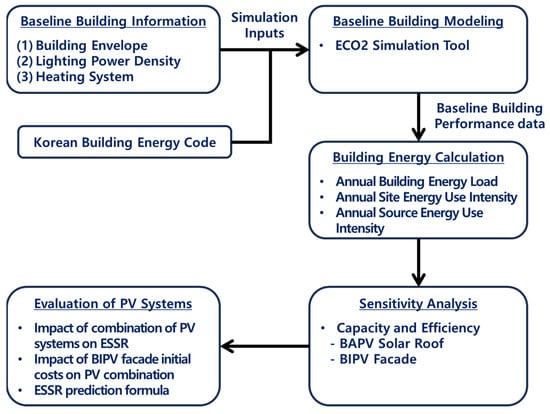
Figure 2.
Flowchart of ECO2 building energy simulations.
3. Building Energy Modeling
3.1. Baseline Building Energy Modeling
The case study building is a small-scale five-story multi-family public housing building with 28 dwelling units located in Sejong, Republic of Korea. Excluding the first floor, which is a public space, including a lobby and monitoring room, the second to fifth floors consist of seven dwelling units per floor, as shown in Figure 3. This public apartment aims to achieve an energy self-sufficiency rate of over 60% and obtain at least ZEB Grade 3 certification. Each dwelling unit is planned to have an area of 39 m2. The description of the case study building is summarized in Table 2.
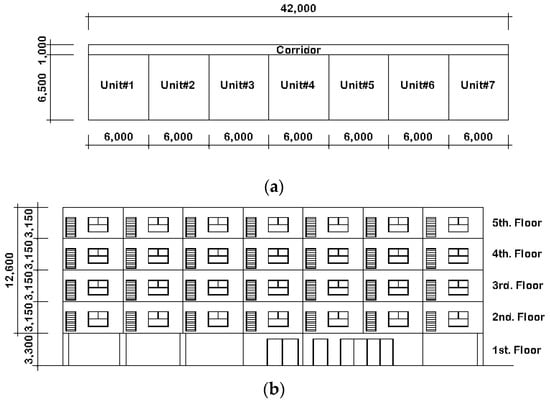
Figure 3.
Schematic drawings of the case study building: (a) floor plan, (b) elevation (unit: mm).

Table 2.
Description of the case study building.
The ECO2 building energy simulation inputs are summarized in Table 3. These inputs are primarily based on reference data from the Energy Saving Design Standards for Buildings of the Korean Government []. According to the Energy Saving Design Standards for Buildings of the Ministry of Land, Infrastructure, and Transport of Republic of Korea, residential buildings can exclude the cooling system from the evaluation criteria for the Zero-Energy Building Certification []. Therefore, the baseline building in this study does not consider the cooling system and has excluded space cooling from the ZEB certification evaluation criteria.

Table 3.
Baseline modeling inputs.
3.2. Parameters for the Sensitivity Analysis
The study applied BAPV on the roof and BIPV on the facade of the baseline building and conducted a sensitivity analysis to assess the impact of the BAPV roof and BIPV facade on the building’s ESSR. The parameters investigated in this study included the installation area and efficiency of the BAPV roof and BIPV facade, as outlined in Table 4.

Table 4.
Description of the options for the sensitivity analysis.
4. Building Energy Simulation Results
4.1. Energy Performance of the Baseline Model
Table 5 presents the results of the ECO2 simulation for the baseline model. Heating accounted for approximately 54.2% of the total building energy load, followed by domestic hot water at 32.3%, and lighting at 13.5%. When considering site energy consumption, calculated taking into account the equipment efficiency and operating hours, heating energy consumption represented 60.2% of the total, domestic hot water 21.0%, lighting 7.9%, and ventilation 10.8%. In terms of source energy consumption, space heating represented 48.0%, domestic hot water 16.3%, lighting 15.1%, and ventilation 20.6%. Overall, heating dominated the building energy performance, highlighting its significant contribution to energy consumption.

Table 5.
Simulation results of the baseline model.
4.2. Results of the Sensitivity Analysis
4.2.1. Impact of PV System Capacities
This study analyzed the impact of capacity changes in the BAPV roof and BIPV facade on the ESSR for the case study building. In the ECO2 simulation, the BAPV roof efficiency and installation angle was fixed at 20% and 30 degrees, respectively, while the BIPV facade efficiency was assumed to be 15%. Notably, when conducting simulations for the BAPV roof or BIPV facade, each type of PV system was simulated independently. In other words, the BIPV facade was not applied during the simulations for the BAPV roof. The simulation results, as shown in Figure 4 and Figure 5, revealed that the ESSR increases linearly as the installation area of both systems increases and the installed capacity increases.
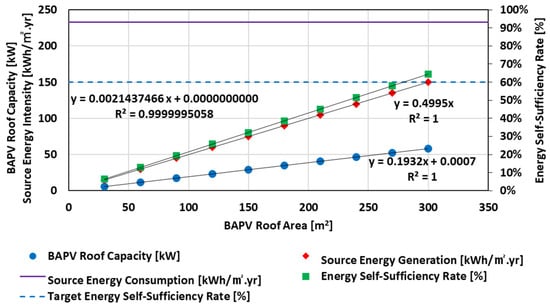
Figure 4.
Source energy intensity for variations in the BAPV roof area.
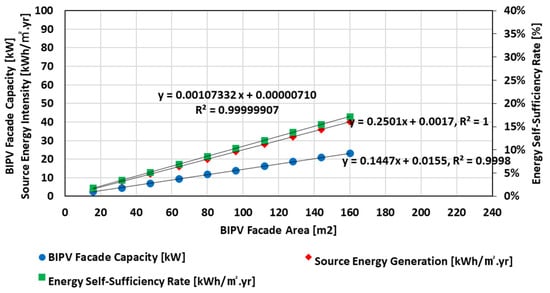
Figure 5.
Source energy intensity for variations in the BIPV facade area.
The simulation analysis results indicate that achieving the target ESSR of 60% solely with either a BAPV roof or a BIPV facade is challenging due to installation area limitations. Specifically, a BAPV roof would need to cover more than 280 m2, while a BIPV facade would require at least 560 m2, according to the linear regression equation. However, local government regulations in Republic of Korea restrict solar panel installation to a maximum of 70% of the flat roof area [,]. Given the total roof area of 300 m2 in the case study building, a BAPV roof can be installed on up to 210 m2 of the horizontal flat roof surface. Applying an installation angle of 30°, the maximum installable area for the BAPV roof is 243 m2. Therefore, achieving the target ESSR necessitates combining both a BAPV roof and a BIPV facade.
4.2.2. Impact of PV System Efficiencies
This study conducted simulations to analyze the impact of changes in the efficiency of the PV system on the ESSR of the case study building. When simulating the BAPV roof, it was assumed that it would be installed on 300 m2 of the roof, with no installation of a BIPV facade. For the BIPV facade, it was assumed that it would cover 160 m2, corresponding to about 30% of the front wall area of 530 m2, without a BAPV roof. As a result of the analysis, it was observed that the change in the building’s ESSR due to efficiency changes followed a linear trend, as shown in Figure 6 and Figure 7. Specifically, for the BAPV roof, an efficiency saving of at least 16% was necessary to achieve the target ESSR for the case study building. However, in the case of the BIPV facade, regardless of how high the efficiency was, the target ESSR of 60% could not be reached. The limitation arises from the BIPV facade installation area being restricted to 30% of the front wall.
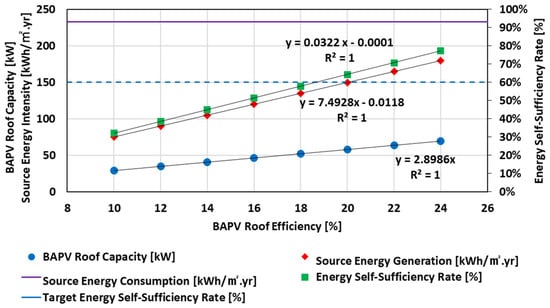
Figure 6.
Source energy intensity for variations in the BAPV roof efficiency.
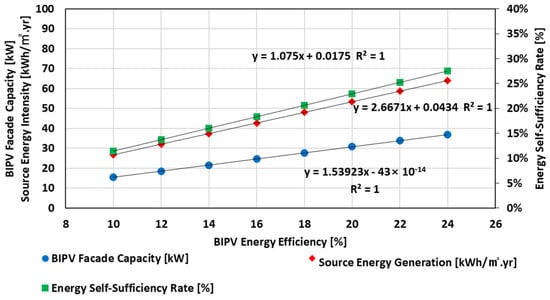
Figure 7.
Source energy intensity for variations in the BIPV facade efficiency.
5. Analysis
5.1. Impact of Combining PV Systems on Achieving the Target ESSR
Since the source energy demand of the baseline model is 233 kWh/(m2·yr), achieving the target ESSR of 60% requires a source energy generation of at least 139.8 kWh/(m2·yr). This study analyzed various combinations of BAPV roofs and BIPV facades to meet the target ESSR, as summarized in Table 6. For this analysis, the PV efficiencies of 20% and 15% were used for the BAPV roof and BIPV facade, respectively. As shown in Table 6, an area of 280 m2 for the BAPV roof alone is sufficient to achieve the target ESSR of 60%. However, due to regulatory constraints, which allows only up to 270 m2 for the BAPV roof installation in the case study building, achieving the target ESSR solely with a BAPV roof is not feasible. Therefore, a combination of a BAPV roof and a BIPV facade is necessary to achieve the target ESSR of 60% for the case study building.

Table 6.
Simulation results for various combinations of BAPV roofs and BIPV facades.
5.2. Impact of BIPV Facade Initial Costs
This study examined the combination of a BAPV roof and a BIPV facade to achieve the target ESSR, considering the installation costs. As shown in Table 7, the baseline installation cost for PV systems was obtained from the Korea Energy Agency’s 2021 report []. Since there are no recent official cost estimates for BIPV facade panels from the Korea Energy Agency (KEA), this research used the cost difference ratio between BAPV roofs and BIPV facades from the 2011 and 2012 KEA reports [,]. Specifically, the cost of BIPV facade panels was assumed to be approximately 2.0 times that of BAPV roof panels, estimated at KRW 2724 per kW.

Table 7.
Standard price per 1 kW for PV systems released by KEA.
To evaluate the effect of the initial cost of a BIPV facade, this study conducted ECO2 simulations for various combinations of BAPV roof and BIPV facade installations needed to achieve the target ESSR of 60%. Different initial costs for a BIPV facade were then applied, as shown in Table 8. Throughout the analysis, the installation areas for BAPV roof and BIPV facade panels, as well as the cost of a BAPV roof, remained constant, while the cost of the BIPV facade was varied.

Table 8.
Unit cost options for a BIPV facade.
Table 9 presents the initial cost associated with different combinations of BAPV roofs and BIPV facades for various implementation surfaces. The minimum initial cost is highlighted in yellow. Notably, for Option 1 and Option 2, a higher utilization of the BIPV facade results in a lower initial cost for implementing PV systems. In contrast, other options achieve the minimum initial cost by using only a BAPV roof. These results indicate that applying a BIPV facade is cost-effective when its initial price, relative to a BAPV roof, is below 62%. Therefore, to promote the extensive adoption of BIPV facades, reducing the initial installation cost through financial support systems, such as government subsidies, is crucial.

Table 9.
The resulting initial cost for various combinations and cost options, with the minimum total value highlighted in yellow.
5.3. ESSR Prediction Models for PV Systems
5.3.1. ESSR Prediction Model Regression Analysis
Table 10 shows variations in the PV capacity, source energy consumption, and ESSR for changes in the BIPV facade area, based on different BAPV roof areas. As shown in Table 10, since the trend of increasing the ESSR with an increase in the BIPV facade area is linear, the required installation area of the BIPV facade for the case study building to achieve net-zero energy can be estimated through linear regression.

Table 10.
Simulation results for various installation areas of the BAPV roof and BIPV facade.
Figure 8 shows that the trend of the ESSR variation with respect to changes in the BIPV facade area remains consistent regardless of the BAPV roof area, indicating only a shift in the y intercept. Figure 9 further demonstrates that the y intercept linearly correlates with the BAPV roof area. By combining these linear regression relationships, Equation (2) could be derived, suggesting that it is feasible to predict the ESSR based on variations in both the BAPV roof and BIPV facade areas for a specific building.
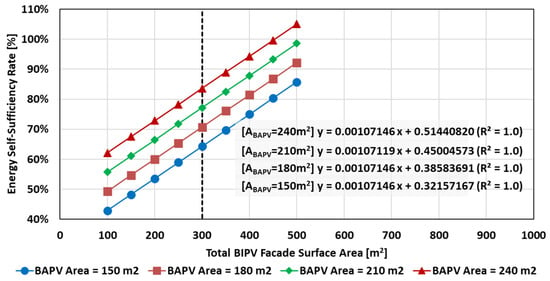
Figure 8.
ESSR variations according to the BIPV facade area and BAPV roof area.
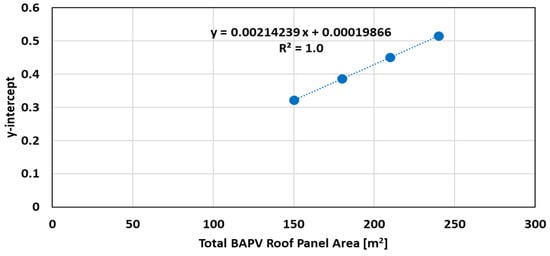
Figure 9.
Relationship between the BAPV roof area and the y intercept in Figure 8.
However, this equation only considers the influence of the installation areas of the BAPV roof and BIPV facade, failing to adequately reflect the direct correlation with the source energy consumption for ESSR calculations. In other words, Equation (1) may show high predictive accuracy for the case study building used to derive Equation (1), however it can lack accuracy when building loads and source energy consumption vary. Therefore, to address such limitations and account for source energy consumption, this study used the correlation between the PV capacity and building source energy consumption to assess the achievable ESSR through PV system implementation.
As shown in Figure 10, the ESSR variation relative to the ratio of the PV capacity to the source energy consumption follows a linear trend. The slope of the change, which varies based on the BAPV roof area, remains consistent, while the y intercept differs. Figure 11 shows that the y intercept linearly correlates with changes in the BAPV roof area. By combining these linear regression equations, depicted in Figure 10 and Figure 11, this study derived Equation (2), which can predict the building’s ESSR.
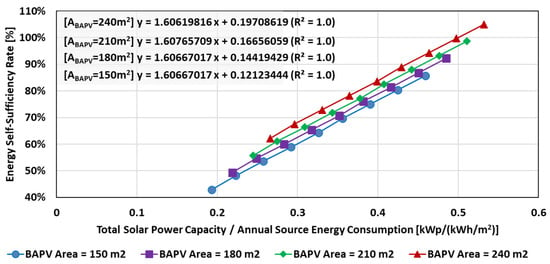
Figure 10.
ESSR variations for the ratio between total PV capacity and source energy consumption.
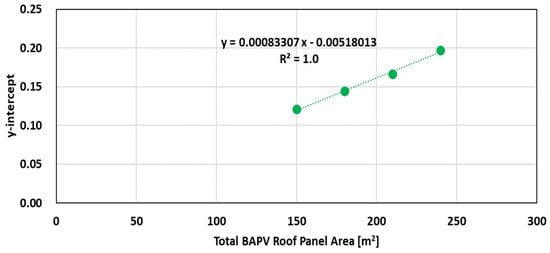
Figure 11.
Relationship between BAPV roof area and y intercept in Figure 10.
5.3.2. Verification of the ESSR Prediction Models
The case building studied in this research was built in August 2023, as shown in Figure 12, along with the floor plan shown in Figure 13. While the main design remained consistent with the conceptual design, the dwelling unit area was expanded beyond the initial plans. Notably, mechanical ventilation was not implemented in the final design. The photographs and specifications of the completed building are presented in Figure 12 and Table 11.

Figure 12.
Images of final design of the case study building: (a) elevation, (b) BIPV facade, (c) BAPV roof.
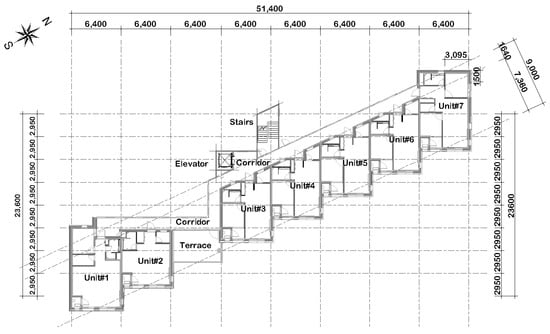
Figure 13.
Floor plan of the final design of the case study building (unit: mm).

Table 11.
Details of the final design specifications of the case study building.
Based on the specifications of the building shown in Table 11, the official results of the Zero-Energy Building Certification of Republic of Korea are presented in Table 12, indicating the final ESSR of 76.9%. This exceeds the target ESSR of 60%. The variation is attributed to changes in the boundary conditions, including envelope U-values, the infiltration rate, and lighting power density, as well as adjustments to the floor area compared to the initial plans.

Table 12.
The official simulation results of the Zero-Energy Building Certification for the case study building.
The ESSR predictions were made using Equations (1) and (2), considering the final building specifications, source energy consumption, and PV capacity. The calculated ESSR prediction from Equation (1) was 66.2%, whereas Equation (2) predicted an ESSR of 74.1%. This discrepancy highlights that Equation (2) provides a more accurate prediction.
The reason lies in that Equation (1) focuses solely on variations in the installation area of PV systems, without directly considering the building’s source energy consumption. While Equation (1) suited the sample data used for its derivation, it exhibited significant errors when the building’s energy usage changed. In contrast, Equation (2) accounts for both PV capacity and source energy consumption, resulting in a more reliable ESSR prediction.
6. Conclusions
This study analyzed various factors related to implementing PV systems for achieving nearly zero energy in small-scale, low-rise, multi-family residential buildings. The analysis was based on a case study building located in Republic of Korea, a newly constructed five-story multi-family residential building with 28 dwelling units. The research investigated the impact of PV capacity and efficiency variations, BIPV facade costs, and the combined effects of a BAPV roof and BIPV facade on the building’s ESSR. Based on these analyses, the study proposed equations to predict the ESSR when implementing PV systems in small-scale, low-rise, multi-family residential buildings in Republic of Korea.
During the conceptual design process, the case study building set a target ESSR of 60%, excluding space cooling and plug loads. To achieve this target ESSR, this study analyzed the impact of PV capacity and efficiency. The simulation results showed that achieving the target ESSR using only a BAPV roof or a BIPV facade would be challenging due to the limited roof area for BAPV systems in multi-family residential buildings and the lower efficiency of BIPV facades compared to BAPV roofs. Therefore, a combination of a BAPV roof and BIPV facade emerges as a viable strategy to achieve the desired ESSR.
Due to the initial cost of a BIPV facade being twice as high as that of BAPV roof, it was more cost-effective to use more BAPV roof panels than BIPV facade panels. To enhance the cost-effectiveness of the BIPV facade, the sensitivity analysis revealed that its initial cost should be 62% lower than that of a BAPV roof. This difference primarily stems from the lower energy performance of BIPV facades compared to BAPV roofs.
Based on the simulation results for various combinations of BAPV roofs and BIPV facades, this study derived equations using linear regression analysis to predict the ESSR for a small-scale, low-rise, multi-family residential building. By utilizing the final design details of the case study residential building, the proposed equation, which considers both the PV capacity and building source energy consumption, was validated to predict the ESSR, which was closely aligned with the actual ESSR.
However, it is important to acknowledge that this study has limitations. Conducted on a specific case study building, further analysis is necessary to determine whether the results can be generalized to multi-family residential buildings of varying scales and locations. Additionally, since this study primarily relied on simulation analysis, future validation using real building energy performance data and PV system-generated energy data is essential.
Despite these limitations, this study differs from previous research by investigating the application of PV systems as a strategy to achieve the ESSR in small-scale, low-rise, multi-family residential buildings in Republic of Korea. This research could be useful for future studies exploring strategies for achieving zero-energy, multi-family residential buildings using PV systems.
Author Contributions
Conceptualization, B.C.K.; Methodology, B.C.K.; Formal analysis, B.C.K.; Investigation, B.C.K.; Data curation, B.C.K.; Writing—original draft, B.C.K.; Writing—review & editing, G.T.K. and I.T.H.; Visualization, B.C.K. and I.T.H.; Supervision, G.T.K.; Project administration, G.T.K.; Funding acquisition, G.T.K. All authors have read and agreed to the published version of the manuscript.
Funding
This research was funded by City Government of Sejong [Sejong New Deal Policy for Urban Regeneration].
Data Availability Statement
The data presented in the study are included in the article material; further inquiries can be directed to the corresponding author.
Conflicts of Interest
The authors declare no conflicts of interest.
References
- International Energy Agency. Efficiency & Demand. Available online: https://www.iea.org/countries (accessed on 22 June 2024).
- U.S. Energy Information Administration. Annual Energy Review 2023. Available online: https://www.eia.gov/totalenergy/data/annual/index.php (accessed on 22 June 2024).
- Korea Energy Economics Institute. 2023 Yearbook of Energy Statistics—Data up to 2022; Korea Energy Economics Institute: Ulsan, Republic of Korea, 2023; ISSN 1226-606X. [Google Scholar]
- Korea Energy Agency. Zero Energy Building Certification. Available online: https://zeb.energy.or.kr/BC/BC00/BC00_01_001.do (accessed on 22 June 2024).
- Korean Statistical Information Service. Housing Census. Available online: https://kosis.kr/eng/statisticsList/statisticsListIndex.do?parentId=I1.1&menuId=M_01_01&vwcd=MT_ETITLE&parmTabId=M_01_01#content-group (accessed on 22 June 2024).
- Wu, W.; Skye, H.M. Residential net-zero energy buildings: Review and perspective. Renew. Sustain. Energy Rev. 2021, 142, 110859. [Google Scholar] [CrossRef] [PubMed]
- Feng, W.; Zhang, Q.; Ji, H.; Wang, R.; Zhou, N.; Ye, Q.; Hao, B.; Li, Y.; Luo, D.; Lau, S.S.Y. A review of net zero energy buildings in hot and humid climates: Experience learned from 34 case study buildings. Renew. Sustain. Energy Rev. 2019, 114, 109303. [Google Scholar] [CrossRef]
- Wells, L.; Rismanchi, B.; Aye, L. A review of Net Zero Energy Buildings with reflections on the Australian context. Energy Build. 2018, 158, 616–628. [Google Scholar] [CrossRef]
- Ullah, K.; Prodanovic, V.; Pignatta, G.; Deletic, A.; Santamouris, M. Technological advancements towards the net-zero energy communities: A review on 23 case studies around the globe. Sol. Energy 2021, 224, 1107–1126. [Google Scholar] [CrossRef]
- Omar, A.I.; Khattab, N.M.; Abdel Aleem, S.H.E. Optimal strategy for transition into net-zero energy in educational buildings: A case study in El-Shorouk City, Egypt. Sustain. Energy Technol. Assess. 2022, 49, 101701. [Google Scholar] [CrossRef]
- Alawode, A.; Rajagopalan, P. Feasibility of net zero energy high rise apartment buildings in Australia. Sol. Energy 2022, 231, 158–174. [Google Scholar] [CrossRef]
- Ni, S.; Zhu, N.; Zhang, Z.; Hou, Y.; Li, S. The operational performance of net zero energy wooden structure building in the severe cold zone: A case study in Hailar of China. Energy Build. 2021, 257, 111788. [Google Scholar] [CrossRef]
- Nematchoua, M.K.; Nishimwe, A.M.; Reiter, S. Towards nearly zero-energy residential neighbourhoods in the European Union: A case study. Renew. Sustain. Energy Rev. 2021, 135, 110198. [Google Scholar] [CrossRef]
- Zhang, X.; Wang, A.; Tian, Z.; Li, Y.; Zhu, S.; Shi, X.; Jin, X.; Zhou, X.; Wei, S. Methodology for developing economically efficient strategies for net zero energy buildings: A case study of a prototype building in the Yangtze River Delta, China. J. Clean. Prod. 2021, 320, 128849. [Google Scholar] [CrossRef]
- Panagiotidou, M.; Aye, L.; Rismanchi, B. Optimisation of multi-residential building retrofit, cost-optimal and net-zero emission targets. Energy Build. 2021, 252, 111385. [Google Scholar] [CrossRef]
- Ali, H.H.; Al-Rub, F.A.A.; Shboul, B. Evaluation of Near-net-zero-energy Building Strategies: A Case Study on Residential Buildings in Jordan. Int. J. Energy Econ. Policy 2020, 10, 325–336. [Google Scholar] [CrossRef]
- Lan, L.; Wood, K.L.; Yuen, C. A holistic design approach for residential net-zero energy buildings: A case study in Singapore. Sustain. Cities Soc. 2019, 50, 101672. [Google Scholar] [CrossRef]
- Alajmi, A.; Rodrígueza, S.; Sailor, D. Transforming a passive house into a net-zero energy house: A case study in the Pacific Northwest of the U.S. Energy Convers. Manag. 2018, 172, 39–49. [Google Scholar] [CrossRef]
- Ascione, F.; Bianco, N.; Böttcher, O.; Kaltenbrunner, R.; Vanoli, G.P. Net zero-energy buildings in Germany: Design, model calibration and lessons learned from a case-study in Berlin. Energy Build. 2016, 133, 688–710. [Google Scholar] [CrossRef]
- Zhou, Z.; Feng, L.; Zhang, S.; Wang, C.; Chen, G.; Du, T.; Li, Y.; Zuo, J. The operational performance of ‘‘net zero energy building”: A study in China. Appl. Energy 2016, 177, 716–728. [Google Scholar] [CrossRef]
- Tsalikis, G.; Martinopoulos, G. Solar energy systems potential for nearly net zero energy residential buildings. Sol. Energy 2015, 115, 743–756. [Google Scholar] [CrossRef]
- Cellura, M.; Guarinoa, F.; Longoa, S.; Mistretta, M. Energy life-cycle approach in Net zero energy buildings balance: Operation and embodied energy of an Italian case study. Energy Build. 2015, 72, 371–381. [Google Scholar] [CrossRef]
- Park, B.R.; Chung, M.H. Analysis of the additional energy-saving potential of residential buildings after mandatory zero-energy buildings to achieve carbon neutrality in South Korea. Build. Environ. 2023, 228, 109908. [Google Scholar] [CrossRef]
- Choi, J.; Kee, D.; Lee, J.; Kim, J.J. Understanding heterogeneous consumer preferences for residential zero-energy buildings (ZEBs) in South Korea: A latent class approach. Sustain. Cities Soc. 2023, 97, 104747. [Google Scholar] [CrossRef]
- Ji, C.; Hong, T.; Kim, H.; Yeom, S. Effect of building energy efficiency certificate on reducing energy consumption of non-residential buildings in South Korea. Energy Build. 2022, 255, 111701. [Google Scholar] [CrossRef]
- Ji, C.; Hong, T.; Kim, H. Statistical analysis of greenhouse gas emissions of South Korean residential buildings. Renew. Sustain. Energy Rev. 2022, 156, 111981. [Google Scholar] [CrossRef]
- Kim, K.S.; Yoo, D.C.; Choi, C.; Jang, H.I. Verification of Energy Usage Based on Standard Building Model Development of Low-Rise Residential Buildings in South Korea. Adv. Civ. Eng. 2021, 2021, 6679108. [Google Scholar] [CrossRef]
- Jung, Y.; Heo, Y.; Cho, H.; Kang, Y.T.; Kim, Y.; Lee, H. A plan to build a net zero energy building in hydrogen and electricity-based energy scenario in South Korea. J. Clean. Prod. 2023, 397, 136537. [Google Scholar] [CrossRef]
- Ji, C.; Choi, M.; Hong, T.; Yeom, S.; Kim, H. Evaluation of the effect of a building energy efficiency certificate in reducing energy consumption in Korean apartments. Energy Build. 2021, 248, 111168. [Google Scholar] [CrossRef]
- Munkhbat, U.; Byun, S.Y.; Lee, D.H. A Study on the Prediction of Achieving of Zero Energy Building Certification in an Apartment House according to Early Adoption of Zero-energy Buildings. J. KIAEBS 2021, 15, 313–325. [Google Scholar]
- Wang, S.; Tae, S.; Jang, H. Prediction of the Energy Self-Sufficiency Rate of Major New Renewable Energy Types Based on Zero-Energy Building Certification Cases in South Korea. Sustainability 2021, 13, 11552. [Google Scholar] [CrossRef]
- Lee, H.; Choi, M.; Lee, R.; Kim, D.; Yoon, J. Energy performance evaluation of a plus energy house based on operational data for two years: A case study of an all-electric plus energy house in Korea. Energy Build. 2021, 252, 111394. [Google Scholar] [CrossRef]
- Yang, S.; Cho, H.M.; Yun, B.Y.; Hong, T.; Kim, S. Energy usage and cost analysis of passive thermal retrofits for low-rise residential buildings in Seoul. Renew. Sustain. Energy Rev. 2021, 151, 111617. [Google Scholar] [CrossRef]
- Kim, Y.; Yu, K.H. Study on the Certification Policy of Zero-Energy Buildings in Korea. Sustainability 2020, 12, 5172. [Google Scholar] [CrossRef]
- Kwag, B.C.; Han, S.; Kim, G.T.; Kim, B.; Kim, J.Y. Analysis of the Effects of Strengthening Building Energy Policy on Multifamily Residential Buildings in South Korea. Sustainability 2020, 12, 3566. [Google Scholar] [CrossRef]
- Lee, J.; Shepley, M.M.; Choi, J. Exploring the localization process of low energy residential buildings: A case study of Korean passive houses. J. Build. Eng. 2020, 30, 101290. [Google Scholar] [CrossRef]
- Suh, H.S.; Kim, D.D. Energy performance assessment towards nearly zero energy community buildings in South Korea. Sustain. Cities Soc. 2019, 44, 488–498. [Google Scholar] [CrossRef]
- Song, J.; Oh, S.-D.; Song, S.J. Effect of increased building-integrated renewable energy on building energy portfolio and energy flows in an urban district of Korea. Energy 2019, 189, 116132. [Google Scholar] [CrossRef]
- Eum, J.; Kim, Y. Applicability analysis of residential energy storage system (ESS) using Homer in Korea. In Proceedings of the Grand Renewable Energy 2018 Proceedings, Pacifico Yokohama, Yokohama, Japan, 17–22 June 2018. [Google Scholar]
- Kim, T.H.; Jeong, Y.S. Analysis of Energy-Related Greenhouse Gas Emission in the Korea’s Building Sector: Use National Energy Statistics. Energies 2018, 11, 855. [Google Scholar] [CrossRef]
- Kim, S.-Y.; Choi, H.-S.; Eum, J.-H. Energy-Independent Architectural Models for Residential Complex Plans through Solar Energy in Daegu Metropolitan City, South Korea. Sustainability 2018, 10, 482. [Google Scholar] [CrossRef]
- Park, K.S.; Kim, M.J. Energy Demand Reduction in the Residential Building Sector: A Case Study of Korea. Energies 2017, 10, 1506. [Google Scholar] [CrossRef]
- Oh, J.; Hong, T.; Kim, H.; An, J.; Jeong, K.; Koo, C. Advanced Strategies for Net-Zero Energy Building: Focused on the Early Phase and Usage Phase of a Building’s Life Cycle. Sustainability 2017, 9, 2272. [Google Scholar] [CrossRef]
- Cheong, C.H. Appropriate Size of a Net Zero-Energy Multi-Family Housing using PV system. J. KIAEBS 2017, 11, 113–120. [Google Scholar]
- Kim, J.H.; Kim, H.R.; Kim, J.T. Analysis of Photovoltaic Applications in Zero Energy Building Cases of IEA SHC/EBC Task 40/Annex 52. Sustainability 2015, 7, 8782–8800. [Google Scholar] [CrossRef]
- Park, D.J.; Yu, K.H.; Yoon, Y.S.; Kim, K.H.; Kim, S.S. Analysis of a Building Energy Efficiency Certification System in Korea. Sustainability 2015, 7, 16086–16107. [Google Scholar] [CrossRef]
- Lim, J.H.; Kim, S.I.; Song, S.Y. Improvement of Design Criteria in Heating and Cooling Equipment According to the Consolidation of Design Standard for Energy Saving in Apartment Buildings of Korea. J. Korean Sol. Energy Soc. 2014, 34, 89–97. [Google Scholar] [CrossRef]
- Lee, K.-H.; Lee, J.-K.; Yoon, E.-S.; Joo, M.-C.; Lee, S.-M.; Baek, N.-C. Annual measured performance of building-integrated solar energy systems in demonstration low-energy solar house. J. Renew. Sustain. Energy 2014, 6, 042013. [Google Scholar] [CrossRef]
- Ministry of Land, Infrastructure and Transport. Energy Saving Design Standards for Buildings. Available online: http://www.law.go.kr/ (accessed on 22 June 2024).
- Oh, T.-K.; Lee, D.; Park, M.; Cha, G.; Park, S. Three-Dimensional Visualization Solution to Building-Energy Diagnosis for Energy Feedback. Energies 2018, 11, 1736. [Google Scholar] [CrossRef]
- Kim, C.S. The Influence of Unit Plan Shapes to the Energy Eciency of Collective Housing Simulated by ECO2 Software. Korea Inst. Ecol. Archit. Environ. J. (KIEAE J.) 2015, 15, 89–94. [Google Scholar]
- Lee, A.R.; Kim, J.G.; Kim, J.H.; Jeong, H.G.; Jang, C.Y.; Song, K.D. Comparing the actual heating energy with calculated energy by the amended standard building energy rating system for apartment buildings. Korea Inst. Ecol. Archit. Environ. J. (KIEAE J.) 2015, 15, 103–107. [Google Scholar]
- Kwon, J.H.; Jang, H.I.; Kim, M.K.; Park, H.S.; Suh, S.J. Comparison on the Annual Energy Demand by Building Energy Assessment Tool and Dynamic Energy Simulation. In Proceedings of the 2012 Summer Conference of the Society of Air-Conditioning and Refrigerating Engineers of Korea, Pyeongchang, Republic of Korea, 27–29 June 2012; pp. 363–366. [Google Scholar]
- Kim, S.H.; Kwak, Y.H.; Kim, C.S. The Analysis on Energy Performance of Collective Housing using ECO2 and DesignBuilder Softwares. Korea Inst. Ecol. Archit. Environ. J. (KIEAE J.) 2018, 18, 47–54. [Google Scholar]
- Seoul Metropolitan Government. Standards for Installation and Management of Solar Power Facilities in Seoul. Available online: https://www.seoul.go.kr (accessed on 22 June 2024).
- National Agency for Administrative City Construction. Solar Power Facility Installation Guidelines. Available online: https://naacc.go.kr (accessed on 22 June 2024).
- Korea Energy Agency. 2021 Standard Unit Price for Renewable Energy Sources. Available online: https://www.knrec.or.kr/biz/pds/pds/view.do?no=303 (accessed on 22 June 2024).
- Korea Energy Agency. 2012 Standard Unit Price for Renewable Energy Sources. Available online: https://www.knrec.or.kr/biz/pds/businoti/view.do?no=598 (accessed on 22 June 2024).
- Korea Energy Agency. 2011 Standard Unit Price for Renewable Energy Sources. Available online: https://www.knrec.or.kr/biz/pds/businoti/view.do?no=395 (accessed on 22 June 2024).
Disclaimer/Publisher’s Note: The statements, opinions and data contained in all publications are solely those of the individual author(s) and contributor(s) and not of MDPI and/or the editor(s). MDPI and/or the editor(s) disclaim responsibility for any injury to people or property resulting from any ideas, methods, instructions or products referred to in the content. |
© 2024 by the authors. Licensee MDPI, Basel, Switzerland. This article is an open access article distributed under the terms and conditions of the Creative Commons Attribution (CC BY) license (https://creativecommons.org/licenses/by/4.0/).